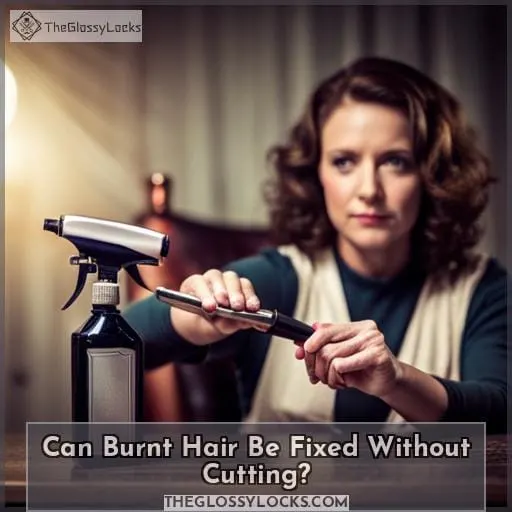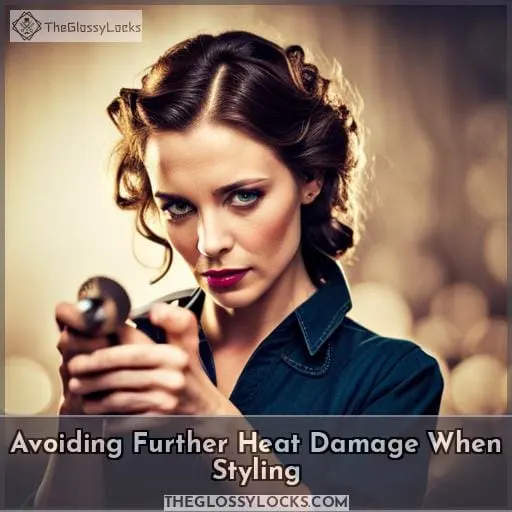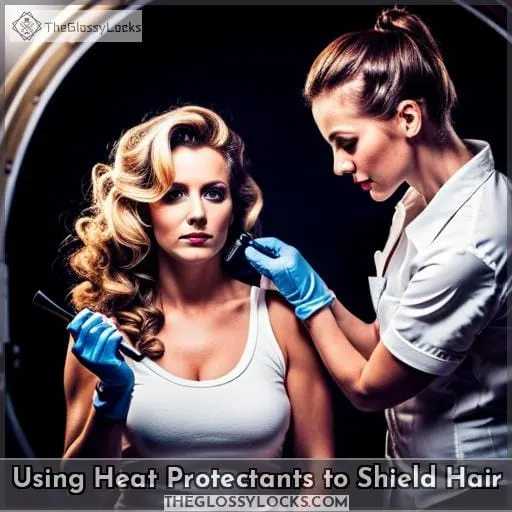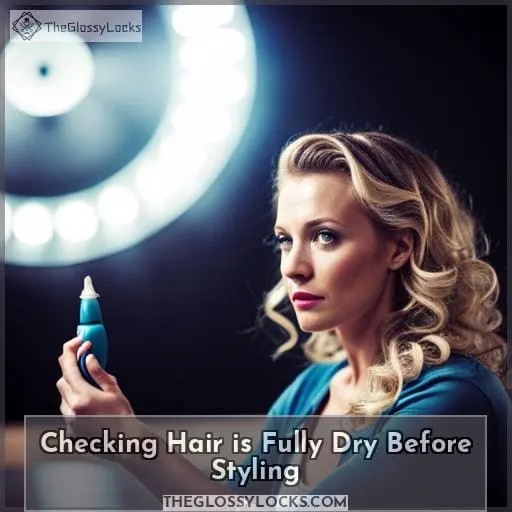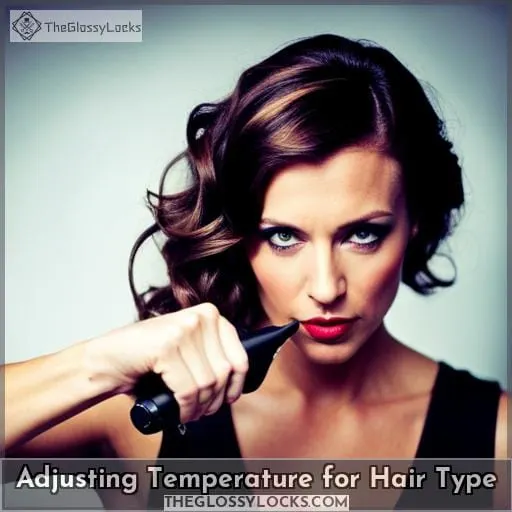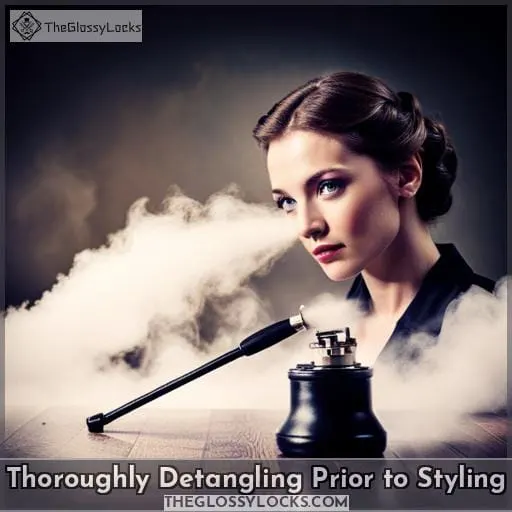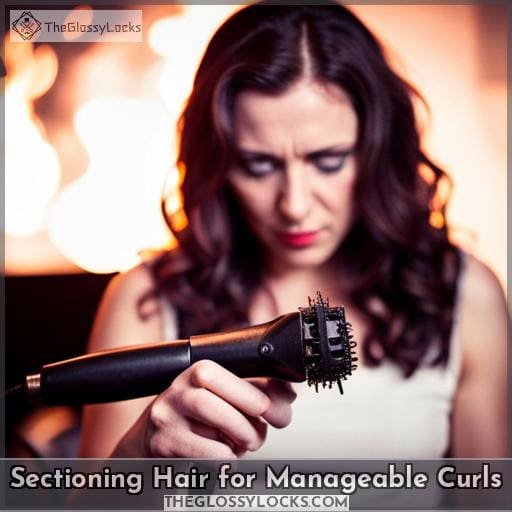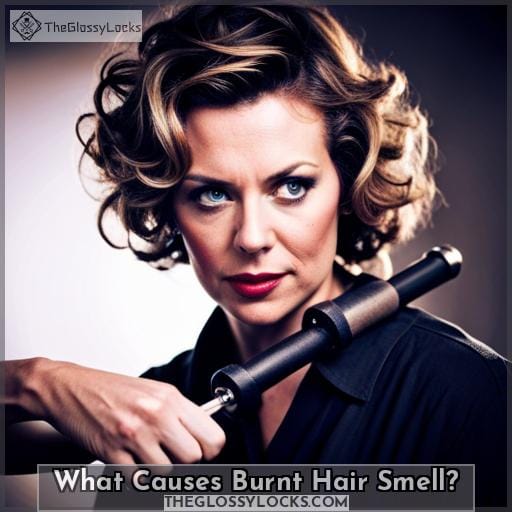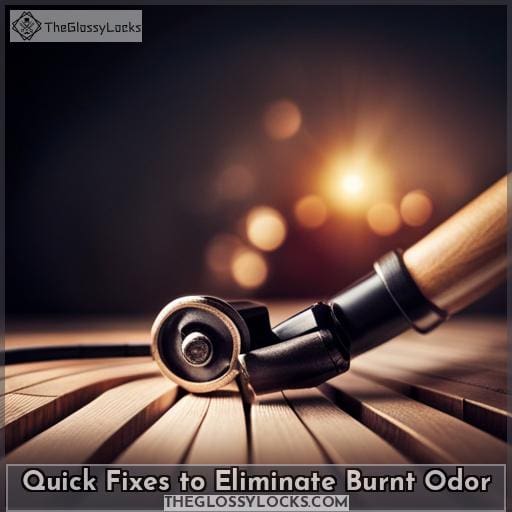This site is supported by our readers. We may earn a commission, at no cost to you, if you purchase through links.
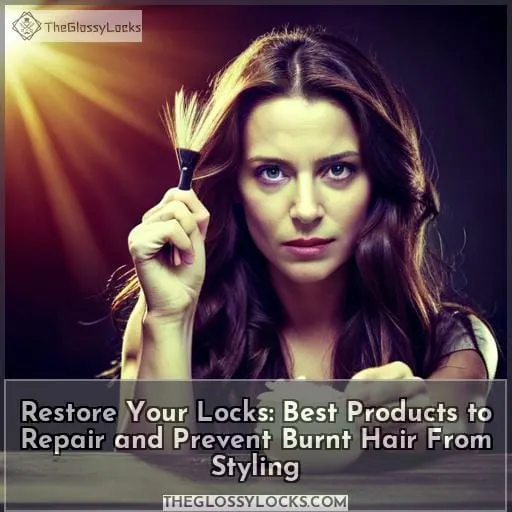 If your locks have felt the wrath of overheated styling tools, don’t despair—with some TLC, you can nurse those frazzled strands back to health.
If your locks have felt the wrath of overheated styling tools, don’t despair—with some TLC, you can nurse those frazzled strands back to health.
Applying the right heat protectants and adjusting your technique can prevent further damage, while targeted treatments like argan oil can restore strength and shine so your hair looks its best.
Focus on gentle, nourishing products and empower yourself with knowledge so you can rock gorgeous, healthy curls free from breakage or burnt odors.
Table Of Contents
- Key Takeaways
- 5 Best Products to Repair Burnt Hair
- 1. HSI Professional Argan Oil Heat Protector
- 2. FoxyBae Heat Protectant Hair Spray Thermal Frizz Damage
- 3. Coconut Argan Oil Heat Protectant Spray Blend Paraben and Dye Free
- 4. Matrix Miracle Leave in Conditioner Detangle Moisturize Heat Protectant
- 5. Sun Bum Vegan Cruelty Free Hair Heat Protector Spray
- Can Burnt Hair Be Fixed Without Cutting?
- Avoiding Further Heat Damage When Styling
- Using Heat Protectants to Shield Hair
- Checking Hair is Fully Dry Before Styling
- Adjusting Temperature for Hair Type
- Thoroughly Detangling Prior to Styling
- Sectioning Hair for Manageable Curls
- What Causes Burnt Hair Smell?
- Quick Fixes to Eliminate Burnt Odor
- Frequently Asked Questions (FAQs)
- Can burnt hair be fixed without cutting?
- How can I avoid causing further heat damage when styling my hair?
- What are the benefits of using heat protectants to shield hair from damage?
- Why is it important to check that hair is fully dry before styling with heat tools?
- Why is it recommended to adjust the temperature of a curling iron based on hair type?
- Conclusion
Key Takeaways
- Use heat protectant sprays with nourishing oils before curling hair
- Adjust curling iron temperature based on your hair type
- Thoroughly detangle hair and section for manageable curls
- Treat hair with masks, leave-in conditioners, and argan oil to nourish damaged strands
5 Best Products to Repair Burnt Hair
If you’ve experienced the stench and crispy texture of burnt tresses, selecting targeted products is imperative for restoring weak strands.
We’ll explore five stellar solutions loaded with nourishing ingredients to breathe new life into frazzled locks from root to tip; these MVPs repair existing damage while shielding hair from additional assaults during heat styling sessions.
1. HSI Professional Argan Oil Heat Protector

You’ll find the HSI Professional Argan Oil Heat Protector shields hair from heat damage while moisturizing as a leave-in conditioner. This weightless mist protects up to 450°F, doubling as a conditioning serum to hydrate and detangle without residue.
Suitable for all hair, the sulfate-free formula makes hair soft and speeds up drying time.
- Shields from heat damage
- Lightweight, no residue
- Conditions, hydrates, detangles
- Speeds up drying time
- Complaints of leaking bottles
- Can get heavy if overapplied
- Need to find right amount
2. FoxyBae Heat Protectant Hair Spray Thermal Frizz Damage
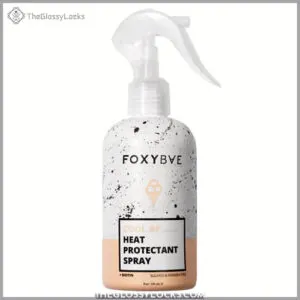
Shield hair from heat damage up to 400°F with FoxyBae’s repairing and smoothing heat protectant spray formulated with hair-healthy biotin, keratin, and nourishing ingredients. Infused to repair existing damage from heat styling while preventing further breakage, this lightweight mist leaves hair silky smooth, soft and frizz-free with a healthy shine.
- Repairs and prevents heat damage
- Smooths and softens hair
- Lightweight, non-greasy formula
- More expensive than drugstore brands
- Scent may not appeal to all
- Requires consistent use for best results
3. Coconut Argan Oil Heat Protectant Spray Blend Paraben and Dye Free
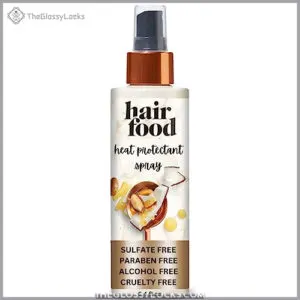
Test this nourishing blend, free of dyes and parabens, protecting hair to 450°F with coconut and argan oils. The weightless spray conditions, softens, and adds shine without weighing hair down, making it suitable for all hair types to maintain sleek styles.
- Heat protection up to 450°F
- Lightweight, non-greasy formula
- All hair types
- Softens and conditions
- Controls frizz
- Strong tropical coconut fragrance
- Not cruelty-free
- Can feel sticky in humidity
4. Matrix Miracle Leave in Conditioner Detangle Moisturize Heat Protectant
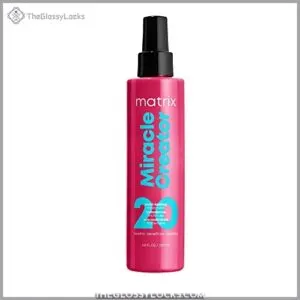
Try Matrix’s Miracle Leave In Conditioner to tackle frizz, dryness, tangling, and heat damage while moisturizing as both a detangler and heat protectant. With 20 beauty benefits, this versatile pro styling product shields against heat, eases blow dries, and promotes soft, smooth, manageable hair.
Sulfate-free with a pleasant scent, it revives damaged locks without weighing them down.
- Shields against heat damage
- Softens and detangles
- Lightweight formula
- Expensive
- Not for daily use
- Strong fragrance
5. Sun Bum Vegan Cruelty Free Hair Heat Protector Spray
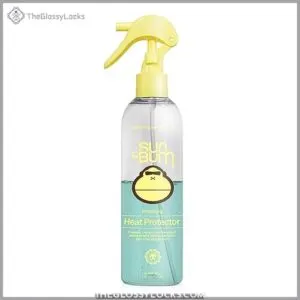
You’ll find the Sun Bum Vegan Cruelty Free Hair Heat Protector Spray decreases blow-dry time while guarding against heat damage.
With a nourishing, vegan formula enriched by sea minerals, this frizz-control mist shields all hair types from breakage up to 450°F. The two-phase spray also smooths flyaways and conditions strands with noni and sea kelp while remaining cruelty-, sulfate- and paraben-free.
- Lightweight formula decreases blow-dry time
- Guards against heat damage up to 450°F
- Controls frizz and flyaways
- Nourishes with sea minerals
- Possible leakage issues
- Needs thorough shaking before use
- Can feel sticky in humidity
Can Burnt Hair Be Fixed Without Cutting?
If you’ve experienced burnt hair from styling, you may be wondering if there’s a way to fix it without resorting to cutting.
The good news is that with some adjustments to your routine, you can help improve burnt hair’s condition over time without needing to chop it off. Focus on intensely hydrating and strengthening strands using moisture-binding masks.
Look for reconstructing shampoos with proteins to fill in gaps from heat damage. Lastly, mitigate further breakage by being extra gentle when brushing and using a heat protectant religiously.
- Implement deep conditioning treatments
- Use protein-infused products
- Apply nourishing hair oils
- Switch to gentle, reparative shampoos
Avoiding Further Heat Damage When Styling
Since burnt hair can be fixed without cutting if handled properly, you’ll want to take precautions to prevent causing additional damage when heat styling your fragile strands.
Heat-Free Styling
- Embrace heat-free styles like braids, buns, or ponytails.
- Allow hair to air dry instead of blow drying.
- Style with velcro or fabric rollers instead of hot ones.
Smart Temperature
- Adjust temperature based on hair type – thin hair at 300°F, thick hair at 400°F.
- Use temperature display tools to monitor heat.
- Set a timer for regulated heat exposure – 8-10 seconds per curl.
Thoroughly detangle hair before curling to avoid breakage. Section hair properly and use clips for manageable, even curling. Lock in moisture with a heat protectant spray containing nourishing oils to avoid sizzling fragile strands.
With mindfulness of heat, secure detangling, and moisture-locking tactics, you can master damage-free curling!
Using Heat Protectants to Shield Hair
With heat protectants, you’re guarding strands before grabbing hot tools. Innovations like FoxyBae’s biotin-infused formula repair existing damage while preventing further breakage up to 400°F.
If you want a DIY approach, apply argan or coconut oil pre-styling for natural heat defense.
When rotating styling products, ensure adequate protection against excessive temperatures.
For heat-free hairstyles, embrace your natural texture using leave-in treatments or protective styles to give damaged areas time to recover.
Getting creative without hot tools prevents worsening breakage so hair can bounce back healthy.
With caution, educate yourself on appropriate temperatures and nurturing products so you can keep stylish looks minus the damage.
Checking Hair is Fully Dry Before Styling
Ensure your hair is completely dry before using a curling iron to prevent sizzling.
- Pat hair with a towel; don’t rub vigorously.
- Allow hair to air dry or use a blow dryer on a cool setting.
- Check hair’s moisture level before curling. If strands still feel damp, give hair more time to dry fully.
Letting hair air dry naturally is ideal, but can increase curling time. Blow drying on low heat will cut down on drying time while minimizing potential harm. For same-day styling, ensure no moisture remains or risk burning strands. Schedule curling sessions accordingly, allowing enough drying time even in humidity or other unfavorable conditions.
With patience and the proper precautions, luscious locks free from heat damage await.
Adjusting Temperature for Hair Type
You’ll often need to adjust the curling iron’s temperature based on your hair type to avoid excessive heat exposure.
Fine hair requires lower heat settings below 300°F to prevent fried strands.
Medium-textured hair can handle around 320-350°F, while coarse, thick hair may need 370-400°F to hold a curl.
However, apply a heat protectant first regardless of texture, and keep check of exposure duration to 8-10 seconds max per section.
Choosing the right temperature for your hair density and texture is key to achieving gorgeous curls without causing burnt hair or damage.
Using an incorrect heat level can lead to breakage, dryness, and fried locks.
With the proper temperature adjustments and quality products shielding strands, you’ll have fabulous, smooth curls free from scorching.
Thoroughly Detangling Prior to Styling
Before you style your hair, make sure you thoroughly detangle it to prevent snagging and breakage while curling.
Working through tangles first allows the wand to smoothly wrap hair without pulling, preventing weakened areas prone to splits. Your curls will have a flawless finish without frizz from broken strands catching.
Use a pre-styling treatment to nourish while combing for optimized protection. Conditioning oils lubricate to gently separate strands, readying hair for a snag-free session.
With heat already damaging delicate locks, avoiding preventable breakage preserves your flowing, healthy mane.
We know freedom means confidently wearing carefree curls without damage weighing you down. Take this simple step first so your styles last longer with strength intact to lift your spirit.
Sectioning Hair for Manageable Curls
After thoroughly detangling prior to styling, you’ll want to section hair for more controlled and uniform curls.
Divide clean, brushed hair into four manageable sections first with a tail comb before securing with clips.
Start curling each section from bottom up by wrapping hair around a curling wand or iron in one inch segments for eight to ten seconds – no longer to prevent damage! Doing smaller sections allows heat protection products to better shield strands.
But don’t forget prepping tresses with the proper formulations beforehand for extra security against potential breakage from hot tools during the curling process for defined, frizz-free locks.
What Causes Burnt Hair Smell?
You’ve likely noticed an unpleasant burnt odor emanating from your locks after heat styling.
- Overheating tools burn hair and release a smell.
- Product buildup traps odors in strands.
- Chemical treatments can react with heat to produce a burnt scent.
Let’s explore solutions to banish this burnt hair smell for good.
Overheating Tools Cause
Through using excessively high heat settings on your styling tools, you’re causing burnt hair smell.
- Cranking up the heat beyond your hair’s tolerance threshold
- Forgetting to adjust settings based on hair type
- Neglecting to use heat protectants to shield strands
By mindfully regulating temperature, selecting products to defend tresses, and remembering every mane has unique needs, you can style sensibly and savor locks sans scent.
Product Buildup Trapped Odors
How can buildup from hair products trap odors and cause burnt hair smell?
Over time, product residue can accumulate, trapping odors. Clarifying your hair is key—use a clarifying shampoo weekly and apple cider vinegar rinses. Deep condition after clarifying to avoid dryness. Additionally, avoiding harsh chemicals, trimming hair regularly, and shampooing thoroughly will help minimize buildup and burnt odors.
| Cause | Solution |
|---|---|
| Oil-based products | Clarifying shampoo |
| Silicone residue | Apple cider vinegar rinse |
| Infrequent washing | Deep conditioner |
Chemical Reactions Release Smell
Your hair’s burnt odor can also come from chemical reactions between products and treatments you use.
When chemicals in hair color, bleach, dye, and straightening treatments interact with heat from hot tools, irritating fumes get released that leave lingering burnt smells in your hair.
Opt for gentle, nourishing products without harsh ingredients to avoid these unpleasant chemical reactions that cause unpleasant burnt hair smells after heat styling.
Quick Fixes to Eliminate Burnt Odor
To quickly eliminate the burnt hair odor, try these effective fixes.
First, create a baking soda paste by mixing equal parts baking soda and water.
Apply the paste to damp hair before shampooing and leave it on for 5-10 minutes to absorb odors.
Then, rinse your hair thoroughly with a vinegar rinse made by combining one part white vinegar with three parts water. This will help neutralize any remaining smells and leave your hair fresh-smelling.
Additionally, consider switching to different products or brands that are specifically formulated to combat strong odors. Incorporating regular product rotation can also prevent buildup that contributes to unpleasant smells in the future.
Lastly, make sure you section your hair properly when styling to avoid excessive heat exposure and potential burning of strands.
Frequently Asked Questions (FAQs)
Can burnt hair be fixed without cutting?
Yes, burnt hair can be repaired without cutting, but it requires diligent aftercare.
Use nourishing oils, masks, and treatments regularly while avoiding heat styling to help damaged strands recover strength and elasticity over time.
With patience and a restorative routine, burnt hair’s appearance and texture can substantially improve.
How can I avoid causing further heat damage when styling my hair?
When heat styling, always use a thermal protectant.
Adjust tools to the lowest effective temperature for your hair type.
Work in sections to avoid extended heat exposure.
Let hair cool between passes.
What are the benefits of using heat protectants to shield hair from damage?
Heat protectants form a barrier between hot tools and strands, shielding follicles from trauma. Like knights guarding a castle, these elixirs allow you to safely access intricate styling while preventing breach to your hair’s integrity.
Why is it important to check that hair is fully dry before styling with heat tools?
When hair is wet, applying heat can boil moisture inside the strands, causing bubble damage.
Allow hair to air dry or gently blow dry to remove excess water before curling or straightening.
This prevents sizzling and additional harm.
Why is it recommended to adjust the temperature of a curling iron based on hair type?
Adjusting curling iron temperature for your hair type prevents excessive heat damage.
Thinner hair requires lower settings to avoid brittle, fried strands.
Coarser hair can withstand slightly higher heat.
But using an appropriate heat setting for your texture allows for bouncy, smooth curls minus the breakage.
Conclusion
Revive your burnt hair from styling tools with these top products and techniques.
Say goodbye to breakage and burnt odors by using heat protectants like HSI Professional Argan Oil Heat Protector and Matrix Miracle Leave in Conditioner.
[Keypoints]Adjust your styling technique by:
- Detangling hair
- Sectioning it for manageable curls
- Using the right temperature for your hair type
Eliminate burnt hair smell with quick fixes.
Don’t fret about cutting your hair—repair it with the right products and methods.
Take control of your hair’s health and rock those gorgeous, healthy curls.

